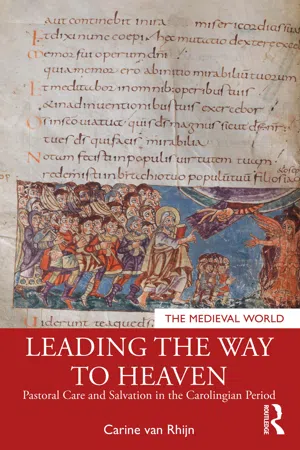
Leading the Way to Heaven
Pastoral Care and Salvation in the Carolingian Period
- 274 pages
- English
- ePUB (mobile friendly)
- Available on iOS & Android
About This Book
Starting from manuscripts compiled for local priests in the Carolingian period, this book investigates the way in which pastoral care took shape at the local levels of society. They show what illiterate lay people learned about their religion, but also what priests themselves knew.
The Carolingian royal dynasty, which ruled over much of Europe in the eighth and ninth century, is well-known for its success in war, patronage of learning and its ambitious style of rulership. A central theme in their plans for the future of their kingdom was to ensure God's everlasting support, and to make sure that all inhabitants – down to the last illiterate farmer – reached eternal life in heaven. This book shows how the ideal of leading everybody to salvation was a central element of Carolingian culture. The grass-roots approach shows how early medieval religion was anything but uniform, how it encompassed all spheres of daily life and how well-educated local priests did not only know how to baptise and preach, but could also advise on matters concerning health, legal procedure and even the future.
This volume is of great use to upper-level undergraduates, postgraduates and scholars interested in the ecclesiastical history of Europe in the Carolingian period.
Frequently asked questions
Part I Foundations
1 Renaissance, reform or correctio? The Carolingians and the quest for salvation
1 Introduction
Table of contents
- Cover
- Half Title
- Series Page
- Title Page
- Copyright Page
- Table of Contents
- Preface
- List of abbreviations
- Introduction
- Part I Foundations
- 1 Renaissance, reform or correctio? The Carolingians and the quest for salvation
- 2 Manuscripts for priests
- Part II Cornerstones
- 3 The cornerstones of Christian society I: Baptism
- 4 The cornerstones of Christian society II: Mass
- 5 The cornerstones of Christian society III: Penance
- Part III Beyond pastoral care
- 6 Priests as experts
- 7 The edges of orthodoxy
- Epilogue
- Appendix 1: The Carolingian priests’ manuscripts featuring in this book
- Appendix 2: Contents of pastoral compendia
- Bibliography
- Index